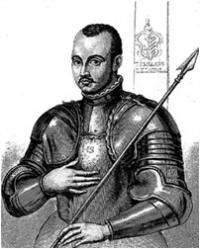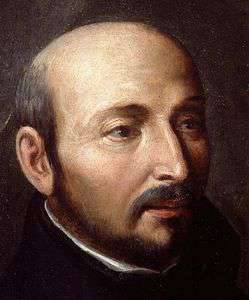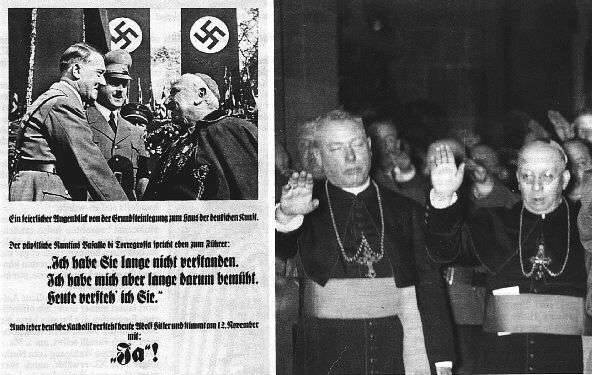As an officer, Ignatius Loyola became a Jesuit, or a new Ukrainian faith.
 In that eventful era, each struggling party put forward figures capable of fully defending the interests of their class. Such figures were in the feudal Catholic gallery. And this category belonged to the founder of the Jesuit Order, Ignatius Loyola. He was considered a completely exceptional person, the savior of the papacy from collapse. Hence, heightened interest in Loyola, and efforts to find in the smallest outline an explanation of certain features of the course stories.
In that eventful era, each struggling party put forward figures capable of fully defending the interests of their class. Such figures were in the feudal Catholic gallery. And this category belonged to the founder of the Jesuit Order, Ignatius Loyola. He was considered a completely exceptional person, the savior of the papacy from collapse. Hence, heightened interest in Loyola, and efforts to find in the smallest outline an explanation of certain features of the course stories.On the first steps of the Jesuit order it is easier to form a clear understanding, knowing about its founder.
And this is what attracts attention, what biographers prefer not to go into: in spite of so enchanting details of the official and unofficial life, the name of Loyola during his lifetime did not thunder. He was mainly known to those clergymen with whom he touched directly. But they also did not hear anything about the miracles of Loyola and did not consider him God's chosen one. Moreover, he was repeatedly persecuted, suspected of heresy, and even betrayed the Inquisition.
No one could then hear about the miracles of Loyola for the simple reason that inventions about their Jesuits began to spread only after his death. In the first two editions of the voluminous life written by the Jesuit Ribadenera, nothing distinct is said about the miracles of Loyola. These editions were published in 1572 and 1587, the second one thirty-one years after Loyola’s death. It was only at the beginning of the 17th century that a new version of the life appeared, where the author tried to explain why he had allegedly “neglected” miracles: it turns out that he thought that Loyola’s holiness was so undoubted for everyone. In the third edition, he corrected his mistake, and here the first time there is a set of imaginary miracles of the founder of the Jesuit Order.
The rules of canonization, that is, enrollment in the saints, require that the candidate being presented has at heart “witnessed” miracles. It was at the beginning of the seventeenth century that the Jesuits conceived to build Loyola to the rank of a saint. It was necessary for the glorification of the "Society of Jesus", which has already managed to penetrate into many European countries and cursed favor with the popes. The church and, of course, the Jesuits themselves created loud advertising for him. Miracles of Loyola were "witnessed" by church authorities, in 1662, the pope declared him to be saints, and the Jesuits were able to take care of the rest.
What remains of the church life of Loyola, if we throw out fictions and embellishments from there?
In his biography two people seem to appear, in many respects different: Loyola before the "conversion" and Loyola in the second half of his life, when he appeared before the world as an intolerant fanatical fanatic, an ambitious, clever politician, a connoisseur of the human heart, able to act farsightedly and mercilessly , slyly, with a cold calculation, sometimes very well versed in a confused situation, maneuvering, hiding, waiting. This second Loyola embodies the very spirit of Jesuitism, which is not abhorred by any means in the struggle.
It must, however, be said that in his youth Loyola was alien to both fanaticism and theocratic aspirations. No matter how much the writers of life lived, attributing to him “righteousness” from early childhood and the desire to provide the greatest services to the church as a young man, he undoubtedly couldn’t think for a very long time that his future would develop in any way similar to it happened in the end.
Loyola was born in 1491 year. He was from well-born but not wealthy Spanish nobles. In the life of a young Loyola there was such a case.
“In March, 1515 of the year in Pamplona (this is the capital of the Spanish autonomous region of Navarre),” writes G. Bemer (Jesuits, M., 1913 Year, p. 103-104), - the bishop's judge and representative of the Correidore of Gipuzkoa province strongly argued each other with a friend because of a young knight who, from the last days of February, was awaiting trial of himself in the prison of the episcopal palace. A young criminal committed a series of “huge crimes” in the province of Gipuzkoa (province in northern Spain, part of the Basque Country), along with one cleric during the funniest nights of the carnival, escaped from the stern hands of the Correidor, fled to Navarre and now claimed that he was also a cleric and consequently, it does not depend on the royal court, but must be accountable for its offenses before the more indulgent court of the church. Unfortunately, the correhidor was able to prove that the accused led a completely non-spiritual life. Therefore, the correhidor energetically demanded that the spiritual court extradite the escaped The church judge could only satisfy this demand. It is very likely that the prisoner was handed over to a secular tribunal and subjected to a harsh punishment. ”
Loyola - “that was the name of the young knight,” Bremer continues. “The acts undoubtedly prove that don Ignatius was not a saint at that time and did not at all strive to become one.”
In May, 1521, thirty-year-old Loyola at the head of the garrison, defended from the French the fortress of that same city - Pamplona, where he had major troubles seven years ago with spiritual and secular authorities. The fighting in the border town of Pamplona went between Spain and France. By that time, Loyola had the rank of captain and led the defense of the fortress, which ended with the defeat of the Spaniards.
In battle, he was seriously wounded in both legs. The French spared their adversary and gave him all the necessary medical care: French doctors performed his first leg surgery. He was sent home for treatment with fractures and soon discovered with horror that one bone had grown crooked. For a man endowed with insatiable ambition, as Loyola was, this misfortune turned out to be unbearable, because it left no hope of returning to military life.
 And Loyola went to the extreme: he ordered to break the bone again. It is easy to imagine how painful this operation was at the then level of surgery. However, Loyola suffered everything. The bone was broken, and it grew together again. But when the popular prints were removed for the second time, a piece of bone that prevented walking was found near the knee. Loyola again turned to the surgeons and ordered to cut off this piece. I had to go through another painful operation - it was all in vain: one leg became shorter than the other. Loyola did not want to surrender here either: a special gate was invented that was used to stretch the leg from day to day. New torture cost the previous ones, but the mutilated leg still remained short for a lifetime.
And Loyola went to the extreme: he ordered to break the bone again. It is easy to imagine how painful this operation was at the then level of surgery. However, Loyola suffered everything. The bone was broken, and it grew together again. But when the popular prints were removed for the second time, a piece of bone that prevented walking was found near the knee. Loyola again turned to the surgeons and ordered to cut off this piece. I had to go through another painful operation - it was all in vain: one leg became shorter than the other. Loyola did not want to surrender here either: a special gate was invented that was used to stretch the leg from day to day. New torture cost the previous ones, but the mutilated leg still remained short for a lifetime.All the biographers of Loyola cite this curious story in order to show the strength of his endurance, will and try to find the very sources of fanatical persistence with which he subsequently overcame obstacles.
It’s really impossible to deny Loyola the recognition of such qualities - it was a strong-willed nature.
It is easy to imagine how despair Loyola fell. But the situation was not hopeless: a promising spiritual field was opening up ahead.
Then it was possible to meet fanatic monks in monasteries who spent their lives in self-torture, fasting and prayer. But the type of clergyman-businessman who saw the spiritual career as a source of enrichment was also widespread. No wonder the nobles vied with each other trying to get the "bread" church positions for their younger sons, when they could not give them a legacy of either great wealth or a prominent position in society.
Ignatius Loyola was the thirteenth child in the family! Even in his childhood years, Loyola’s parents decided to make him a priest over time, and even performed some procedures: in particular, he was drilled on the crown of the tonsure — a bald patch. Young Loyola took advantage of this in order to demand a churchly rather than a secular court for himself during the troubles in Pamplona. But, generally speaking, he then recalled the parental plans as something funny, until everything turned around so that I had to go along this path.
Biographers say that once he, still bedridden, asked for romance of knights. But the relatives, perhaps, considered that it was more decent for him to think about the salvation of the soul: instead of novels he received legends about the saints and a description of the life of Christ. And in Loyola’s consciousness, under the influence of this reading, a turning point was made - he came to believe in his vocation to become a “saint of God.”
A year has passed since the Pamplons siege. Loila decided to carry out his new plans. He could do this simply by disappearing from the "world" with all modesty. One way or another, where to begin, he apparently had no doubts: he spent the night in the monastery of Montserrat, in the chapel of the Virgin, left his weapon - the sword and dagger, then replaced the officer's uniform with rags, began to beg, causing amazement and misinterpretation of acquaintances, and finally, in order to make the whole district speak about himself, he took the traditional last step - began to “escape” in the cave.
Presumably, it was a rather comfortable cave: the newly appeared hermit wrote the book Spiritual Exercises there, which the Jesuits made one of their main guides.
He arrived in Jerusalem in September 1523. There was a representation of the order of the Franciscans. They tried to explain to Loyola that his idea was meaningless, that they could not listen to him and would not listen, that the stated content of future sermons was doubtful, and even if he had listeners and understood his Spanish speeches, it would have ended in trouble with the authorities and the population not placed to pass into another faith.
He realized that with his meager knowledge he could not reach the goal, and, returning to Barcelona, he sat down in Latin.
So two years have passed. Loyola, along with four young people, went first to Alcala to go to university and defeat theology, finally, the theological science, then he went to Salamanca and, finally, to France, to Paris, where the famous Sorbonne was located - the faculty of theology, one of the most authoritative Catholics centers of theology.
No Loyola University lingered. He was attracted not by teaching, but by preaching.
In Alcala, Loyola was arrested by the most holy Inquisition: he was reported as a heretic, his confused speeches made such a strange impression even in Spain, who saw all sorts of examples of preaching zeal. But all the same it went well: he had nothing for his soul, except fanaticism, devotion to the pope. He was released.
Gradually, Loyola came to the conclusion that it was time for a very special asceticism, that the order was still unprecedented, which would become a reliable support for the popes and did not know any other goals besides strengthening papal power. It took him several years until he thought about this idea thoroughly, attracted a group of like-minded people and with their help collected a rather large amount of money needed to start.
15 August 1534, Loyola and his six followers gathered in one of the churches of Paris and gave three ordinary monastic vows, adding to them a new one - a vow of unquestioning obedience to the pope. This day should be considered the first in the history of the Jesuit Order.
Although then Pope Pave III was not inclined to increase the number of spiritual orders. He hesitated for a long time and the Jesuit Order was approved only on 27 September 1540 of the year. In Loyola’s plans, the pope saw an opportunity to fulfill his long-standing desire - to create something like papal janissaries who, unconditionally, without sparing their lives, would serve their sovereign in the fight against Protestantism and heresy. He considered it especially important that Loyola and his comrades put themselves at his fullest disposal and did not indicate this in his constituent bullet, where he stressed that they “dedicated their lives to eternal service to Christ, us and our successors, the Roman high priests” (quote from the book: PN Ardashev. “A Reader in Universal History”, part 1, 1914 year, p. 165).
Ignatius Loyola became the first general of the new society.

He could hardly have imagined that after his death his teaching would continue and find followers in many countries of the world, including Ukraine, where the so-called Jesuit colleges, whose main task today is to prepare fanatically loyal fighters.
Thus, reports began to appear in the media about the destruction of a special Ukrainian unit of the militants "Hundred Jesus Christ", who were trained at a Jesuit college, under Gorlovka in 2014. “The unit included in the special battalion of the Ministry of Internal Affairs“ Shakhtarsk ”was formed from members of the Brotherhood of Dmitry Korchinsky. At the head of the hundreds was the head of the Odessa Brotherhood, Dmitry Linko, the militants of which, together with the visiting radicals of the Right Sector, killed and burned people in the Odessa Trade Union House 2 in May, ”the statement reads.
Information